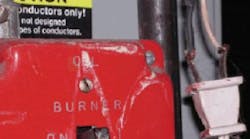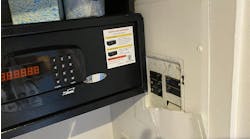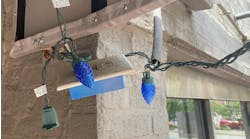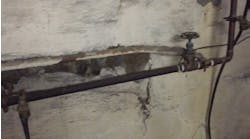Hey, it Works. What's the Problem?
This beautiful piece of work was in the group of photos that John L. Loveland from Ohio shared with me recently (see last month's column). The caption with this photo said, “Pretty safe, isn't it? I mean the hot conductor is at least ¼ in. from a metal oil pipe, and it's almost 48 in. off the ground, so children won't touch it.” Now, there's some sound thinking. It's obvious this installation doesn't satisfy the requirements of the NEC, but exactly how one might remedy this mess is not completely clear.
For example, as noted in Sec. 400.7(B) of Art. 400 (Flexible Cords and Cables), “Where used as permitted in 400.7(A)(3), (A)(6), and (A)(8), each flexible cord shall be equipped with an attachment plug and shall be energized from a receptacle outlet.” Assuming that the heavy-duty cord is supplying the voltage — which one has to assume — then it seems a receptacle must be installed at the line end of the cord to allow for connection of the molded 2-prong plug cap. But is it permissible to supply a surface-mounted receptacle outlet with heavy-duty cord? It doesn't seem so.
If you were to mount a receptacle outlet to provide for connection of the 2-prong molded plug cap, you'd have to determine if the cord were being used in accordance with the rules of 400.8 (Uses Not Permitted), which specifically limits the use of flexible cord as a general wiring method. As stated in 400.8, “…flexible cords and cables shall not be used for the following: (1) As a substitute for fixed wiring of the structure; and (4) Where attached to the building surfaces.” Of course, the Exception to part (4) excludes bus drop cable from that prohibition. So, unless this is a bus drop cable without a cord connector, which I highly doubt, then the entire hookup must be abandoned. A proper branch circuit, or branch circuit extension (using a wiring method recognized by Chapter 3 as suitable for the occupancy and type of application) must be provided.
I have to assume this work was not subject to inspection by a third party. But even if it wasn't, what about self inspection? Where's the person in charge? This is a very unsafe condition that presents a possible shock or electrocution hazard. In fact, this installation is so non-Code-compliant it should be obvious to almost anyone, even an untrained, casual observer.
Unique Bathroom Fan/Light Combo
This shot was also sent in with the group of photos from John L. Loveland. I can hardly believe someone actually pulled this off. The installation is completely ludicrous!
As far as the Code is concerned, it would seem the requirements of 110.3(B) (Installation and Use) have clearly not been met. This Code rule states, “Listed or labeled equipment shall be installed and used in accordance with any instruction included in the listing or labeling.” There's no way the manufacturer intended for the fan to be used in this manner. Nor would I ever believe the fan was evaluated by Underwriters Laboratories (UL) for this type of use.
In scrutinizing this photo, I can't help but wonder how the fan was secured to the outlet box, if there even is one in the ceiling. Additionally, I wonder where the fan cord is located? Does it snake into a box, or is there a flying splice hidden somewhere in the ceiling. If you focus your eye on the mirror reflection, it appears to show a fan control device on the wall above the light switch. That's really scary! As my father used to tell me, “Never underestimate the ingenuity of the human mind.”



